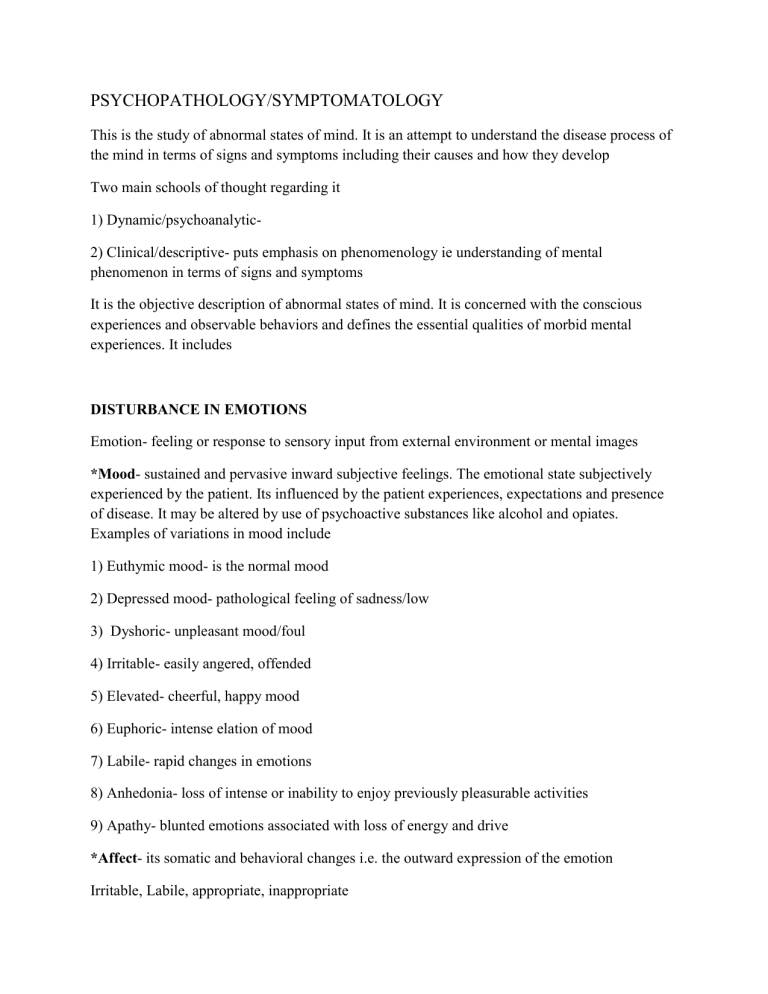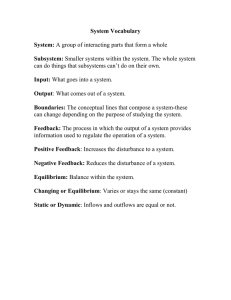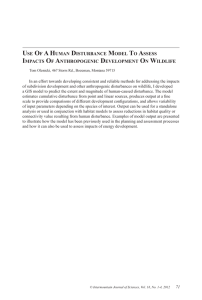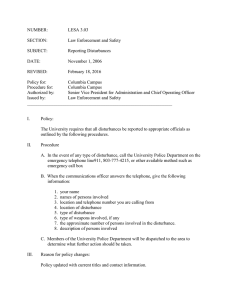MH-EU-MKU,PSYCHOPATHOLOGY
advertisement

PSYCHOPATHOLOGY/SYMPTOMATOLOGY This is the study of abnormal states of mind. It is an attempt to understand the disease process of the mind in terms of signs and symptoms including their causes and how they develop Two main schools of thought regarding it 1) Dynamic/psychoanalytic2) Clinical/descriptive- puts emphasis on phenomenology ie understanding of mental phenomenon in terms of signs and symptoms It is the objective description of abnormal states of mind. It is concerned with the conscious experiences and observable behaviors and defines the essential qualities of morbid mental experiences. It includes DISTURBANCE IN EMOTIONS Emotion- feeling or response to sensory input from external environment or mental images *Mood- sustained and pervasive inward subjective feelings. The emotional state subjectively experienced by the patient. Its influenced by the patient experiences, expectations and presence of disease. It may be altered by use of psychoactive substances like alcohol and opiates. Examples of variations in mood include 1) Euthymic mood- is the normal mood 2) Depressed mood- pathological feeling of sadness/low 3) Dyshoric- unpleasant mood/foul 4) Irritable- easily angered, offended 5) Elevated- cheerful, happy mood 6) Euphoric- intense elation of mood 7) Labile- rapid changes in emotions 8) Anhedonia- loss of intense or inability to enjoy previously pleasurable activities 9) Apathy- blunted emotions associated with loss of energy and drive *Affect- its somatic and behavioral changes i.e. the outward expression of the emotion Irritable, Labile, appropriate, inappropriate Blunted- reduction in intensity of outward expression Flat- no outward signs to express the feelings DISTURBANCE IN THOUGHT- content, form, alienation/control A) Disorders of content- delusions, over valued ideas, obssessions etc *Delusion- a false unshakable belief based on incorrect inference about external reality(firmly sustained) not consistent with a persons intelligence or cultural belief, cannot be corrected by reasoning.(the belief is not one ordinarily acceptable by other members of the persons culture or sub culture eg its not an article of religious faith) 1) Grandiose delusion- inflated self worth, power, knowledge, identity or special relationship to a deity or famous person 2) Bizzare- involves a phenomenon that the person’s culture would regard as totally implausible 3)Delusional jealousy/infidelity- that one’s sexual partner is unfaithful. *Orthello syndrome 4)Erotomania- that another person usually of higher status is in love with the individual. W>m 5) Persecutory- the central theme is that one(or someone to whom one is close) is being attacked, harrassed, cheated, persecuted or conspired against. May take legal action or act in defence 6) Somatic- main content pertains to appearance or functioning of one’s body. involves function of body eg brain is rotten/melting, no stomach, 7) Hypochondriac- belief in one’s illness contraty to medical evidence 8)Nihilistic- extreme pessimism eg that self/others or world is non existent or coming to an end 9)Reference- behavior of others refer to himself , usually of negative nature, connection with ideas of reference *Overvalued ideas- false beliefs but less firmly held (shakable) and can be reasoned. They can occur in normal persons undergoing stressful experiences *Obsessions - Pathological persistence of an irresistible thought or feeling that cannot be eliminated from the mind easily. Patient recognizes these as his own thoughts but he cannot get rid of them e.g. in OCD B) Disorders of form- flow and structure thoughts 1) Neologism- new words created by a patient or a normal word used to mean a different thing 2) Word salad- several words put together with no clear meaning 3) Echolalia- repetition of words or phrases said by another person tend to be repetitive and persistent, at times mocking 4) Derailment- gradually deviates in flow of thought without blocking 5) Circumstantial- indirect speech that is delayed in reaching the point but eventually gets from original point to desired goal. Has over inclusion of details 6) Flight of ideas- rapid thought manifested by fast verbalization and shifting of ideas which tend to be connected to one another 7) Loosening of association- flow of thought in which ideas shift from one subject to another in a completely unrelated way. When severe, speech may become incoherent 8) Thought block- sudden interruption in the stream of thoughts before an idea or thought is completed. 10) Clang association- association of words similar in sound but not in meaning. The words have no logical connection 11) Irrelevant answers- not in harmony with question asked i.e. apparent ignore or not attend to question C) Disorders of alienation/control-The thoughts are controlled by outside forces 1) Thought withdrawal- other people or forces or agents remove one’s thoughts from the mind 2) Insertion- other people or forces are putting thoughts into one’s mind against their wish 3) Broadcasting- one’s thoughts are made known to others without being talked out by the one thinking. 4) Thought echo DISTURBANCE IN SPEECH 1) Pressure of speech- talks a lot and rapidly and it may be difficult to follow the speech eg in mania 2) Poverty- scanty speech eg in psychomotor retardation or depression. Monosyllabic replies mostly 3) Alogia- inability to speak because of mental deficiency or dementia 4) Coprophasia- involuntary use of vulgar or obscene language eg in scz, tourettes disorder 5) Stuttering- frequent repetition or prolongation of a sound or syllable leading to markedly impaired speech fluency DISTURBANCE IN PERCEPTION Perception- process of transferring physical stimulation into psychological information. Mental process by which sensory stimuli are brought to awareness Hallucinations vs illusions *Illusions- arise from false interpretation of stimulus (could be a result of fantasy, intense emotion, lack of perceptual clarity or disease) *Hallucination- false sensory perception not associated with real stimulus. It may be in any of the 5 sensory modalities- vision, touch, taste, smell, sound 1)Visual hallucination-occurs commonly in medical disorders affecting CNS but also in some psychotic patients 2)Tactile- include false perception of touch(haptic), surface sensation as in amputated limb(phantom limb) or even crawling sensations on or under the skin(formication). Occurs in substance abuse as well as other mental illnesses. 3)Olfactory- false smell. Medical conditions mostly 4)Gustatory- false taste. Medical conditions 3 and 4 occur in medical conditions affecting CNS eg epilepsy and other mental illnesses eg depression, scz 5)Auditory- hears voice/sound without any stimulus. The voices may include animal sounds, music, conversations between people or with the patient. They could be familiar or unfamiliar to the patient and could also be derogatory or pleasant. Common in psychotic disorders like scz, mania, psychotic depression. Third person auditory hallucination- voices talk among themselves about the patient Second person- voices talk directly to the patient Commentary voices-talk/describe what the patient is doing/thinking Hallucinations may be mood congruent ie consistent with prevailing mood or also incongruent *Depersonalisation- vs- *Derealization- DISTURBANCE IN MOTOR BEHAVIOR Externally observable abnormal behaviors that depict psyche eg motivations, impulses, drive, instincts, wishes. It may be observed in all forms of mental illness and include; 1)Cataplexy- sudden temporary loss of muscle tone eg in scz, narcolepsy 2)Catalepsy- an immobile position that is constantly maintained for a long time , 3) Catatonic excitement- purposeless motor over activity which sets on suddenly eg in scz 4) Catatonic stupor- marked slowed motor activity often to the point of immobility ie seeming unawareness of surrrounding 4) Echopraxia- imitation of one’s movements by another person 5) Mannerism-habitual involuntary movts and attitudes 6) Akathisia- subjective feeling of restlessness and need to keep on moving eg in adverse effects of antipsychotics 7)Chorea- random and involuntary quick jerking purposeless movements 8) Compulsion- an uncontrollable urge to perform an act repeatedly DISTURBANCE IN ATTENTION Attention- ability to direct one’s activity Concentration- amount of attention exerted in focusing on certain portions of an experience Att and conc may be impaired in dissociative states, anxiety states, depressed patients etc 1) Distractability- inability to concentrate ie attention is easily diverted to other activities that are irrelevant eg in manic states 2) Trance- a dream like state when attention is focused on one thing and the person seems oblivious of his surrounding eg in hypnosis and dissociative disorders and in ecstatic religious experience 3) Selective inattention- in which one blocks away from consciousness things that generate anxiety 4) Hypervigilance- excessive attention is concentrated on a stimuli. Often secondary to paranoid and delusional state DISTURBANCE IN MEMORY Memory-function by which information stored in brain is recalled to consciousness vs Orientation- normal state of oneself and one’s surrounding in terms of time, place and person Most affected in medical illness that affect brain eg dementia and other degenerative disorders Para amnesias- falsification of memory by distortion of recall. may occur in some patients going thro stressful life experiences eg terminal illness, bereavement, after alcohol abuse eg Confabulation- unconcious filling of gaps in memory by imagined or untrue experiences that a person believes but that have no basis in fact Déjà vu- illusions of visual recognition in which a new situation is incorrectly regarded as a repetition of previous memory Jamais vu- false feeling of unfamiliarity with a real situation that a person has experienced Amnesia- partial or total inability to recall past experiences Retrograde amnesia-amnesia of events occurring before a point in time Anterograde amnesia- amnesia of events occurring after a point in time DISTURBANCE IN CONSCIOUSNESS C- astate of awareness of the self and the environment. Its disturbance are often associated with apparent brain pathology eg trauma, epilepsy, narcolepsy, CNS infections, tumours. Altered states of consciousness include 1) Coma- deep/profound unconsciousness 2) Stupor- lack of response and unawareness of surrounding 3) Delirium- dream like change in consciousness often accompanied by an impaired reality testing. Patient may be anxious, restless, confused, hallucinations 4) Drowsiness- state of impaired awareness associated with a desire or inclination to sleep 5) Somnolence- abnormal drowsiness




